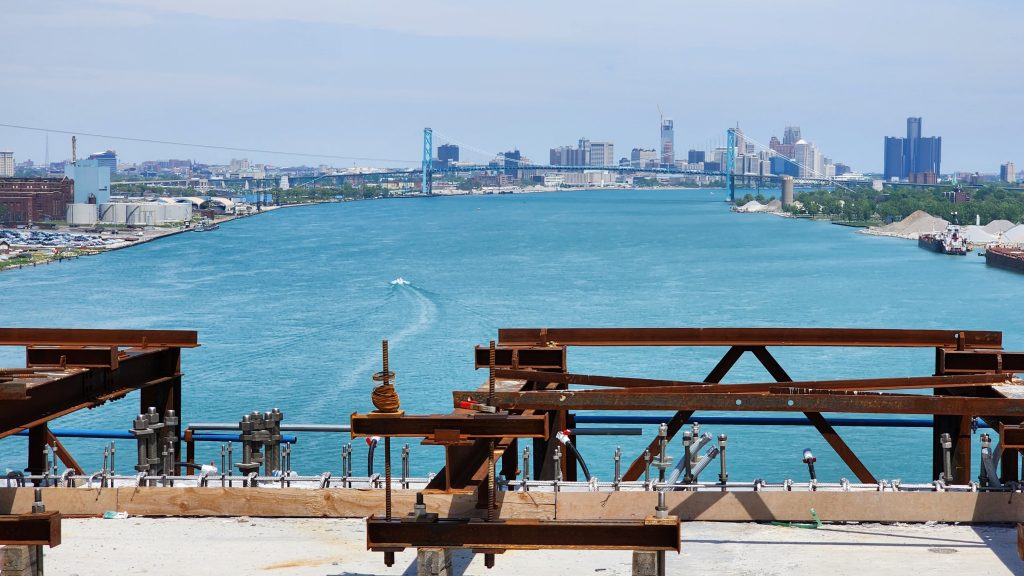The Metro: How is the Gordie Howe Bridge construction impacting residents?
John Filbrandt September 10, 2024Simone Sagovac, director of the Southwest Detroit Community Benefits Coalition, joined the show to discuss the impact the bridge has had on city residents.

The Detroit skyline from the Gordie Howe International Bridge, still under construction.
The Gordie Howe International Bridge is expected to be complete in 2025.
The bridge is being built in Detroit’s Delray neighborhood in Southwest Detroit — a place where, for years, residents have faced issues associated with heavy industry. Now, residents are dealing with the challenges that come with the construction of a roughly $4.2 billion international bridge.
Simone Sagovac, director of the Southwest Detroit Community Benefits Coalition, joined The Metro on Tuesday to help us understand the impact the bridge has had and will have on residents.
Subscribe to The Metro on Apple Podcasts, Spotify, NPR.org or wherever you get your podcasts.
In 2017, the group helped secure an almost $50 million benefits package for people living in the area. One of the overall issues people in the community face has to do with truck traffic, Sagovac says. During the coalition’s data gathering efforts, they counted 1,200 trucks driving on Livernois Street in one day.
“Something that wasn’t really anticipated was, you know, the scale of a development like this. It is the largest infrastructure project that both countries have had in 100 years and it’s 165-plus acres,” Sagovac said. “And when they’re in the thick of construction, and there’s no grass, and no trees covering that dirt – the dust has been a huge problem for the community. People have chronic sinus conditions. Asthma accelerated in the area. And the project is trying to do things with street sweeping but the dirt gets carried on the trucks and these trucks are allowed to drive on residential streets.”
Use the media player above to hear the full interview with Simone Sagovac, director of the Southwest Detroit Community Benefits Coalition.
More headlines from The Metro on Sept. 10, 2024:
- The Detroit area is home to one of the largest groups of people with sickle cell disease in the country. The painful disease is caused by an inherited genetic mutation and most of the people who have it are Black. For decades, there weren’t many treatment options for the disease outside of pain medication. But in recent years, new medical technologies have helped alleviate and even cure sickle cell disease. Larenz Caldwell, a sickle cell patient who underwent a stem cell transplant six years ago; and Outlier Media Science Reporter Koby Levin joined the show to discuss.
- The Detroit Fiber Club is hosting an immersive exhibit showcasing environmental- and fiber-based art at the Boyer Campbell Building in Milwaukee Junction through Sept. 28, as part of the Detroit Month of Design. To discuss the exhibit, we were joined by Co-Curators Sarah Rose and Lisa Waud, and Detroit Fiber Club Managing Director Meg Morley.
- Detroit Artist LeKela Brown is kicking off the College for Creative Studies’ Woodward Lecture Series. The CCS graduated joined The Metro to talk about her work and her first solo-presentation, “From Scratch: Seeding Adornment,” currently on display at the Museum of Contemporary Art Detroit.
Listen to The Metro weekdays from 11 a.m. to noon ET on 101.9 FM and streaming on-demand.
Trusted, accurate, up-to-date.
WDET strives to make our journalism accessible to everyone. As a public media institution, we maintain our journalistic integrity through independent support from readers like you. If you value WDET as your source of news, music and conversation, please make a gift today. Donate today »Author
-
Jack Filbrandt is an assistant producer on WDET's daily news, arts and culture program, The Metro. He grew up on Lake Michigan and has called Detroit home for seven years. He's also a Detroit Documenter, covering local government meetings in the city. He previously worked for Wayne State's student newspaper, The South End, and The Battering Ram.
